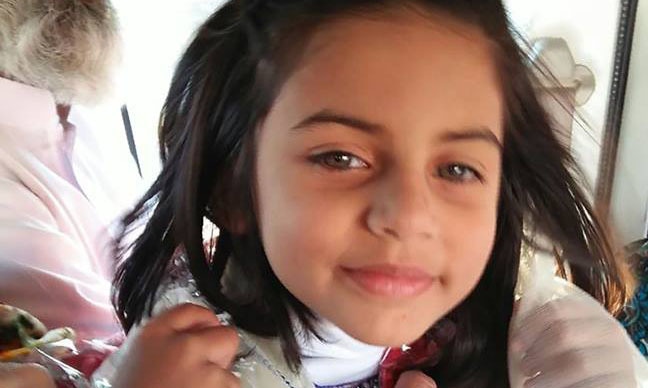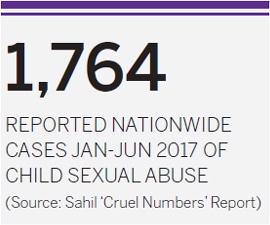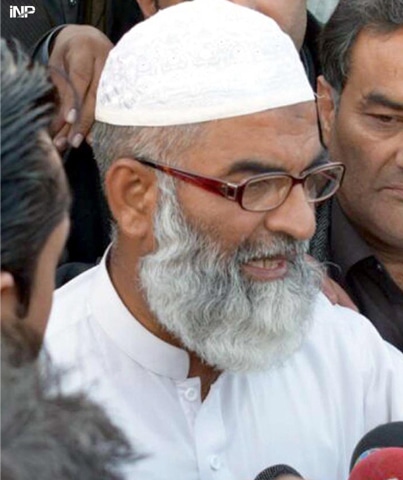Is Kasur really the hub of child sexual abuse in Pakistan?

It hasn’t even been a fortnight since seven-year-old Zainab Ansari was raped and killed but Kasur is back to its ways: ten rupees will buy you all kinds of child pornography in the bazaars of Kasur. The bestiality involved in Zainab’s rape and murder now seems an afterthought; there are ample consumers of child pornography still around.
The demons in Kasur have been laid bare for the past three or four years for the worst of crimes: the sexual abuse of children. In 2015, a child pornography ring was busted, where more than 200 children of the Hussain Khanwala village were being filmed. Through the mechanisms of fear and threat to life, these children and their families were pressured to keep silent. As per statistics compiled by non-governmental organization, Sahil, 285 cases of child sexual abuse were recorded in this case.
Read: Shame, guilt and child abuse
The ring was busted and those involved were caught — young men in their 20s and 30s. The patron of this ring was alleged to an MPA from the ruling Pakistan Muslim League-Nawaz, Malik Saeed. He is accused of having, at the very least, protected the gang and financed their bail. Eventually the matter faded away in public imagination and the news but Kasur has been associated with child sexual abuse ever since.
But while the media’s glare shifted away, the number of girls having been raped and killed in Kasur piled up.
The brutal rape and murder of seven-year-old Zainab has once again focused the media spotlight on the small Punjab town, which seems to be the hub of crimes against children. Is its reputation justified?
Some of it has been attributed to a serial killer and rapist, with Zainab being the twelfth murder victim in the span of just an year. “We kept losing our children and yet the police just sat clasping their hands, waiting for the next case to appear,” says Irshad, a resident of Kasur, who had also taken part in the protest that emerged in the wake of Zainab’s murder. Much of the citizens’ anger was directed at the administration.
However, the alleged serial killer’s involvement in the total number of children in Kasur whose rape was recorded is miniscule. According to Sahil, an NGO that works on the specific area of child sexual abuse, statistics for the first six months of 2017 reveal that in Kasur alone, a total of 129 cases of child assault were reported. Of these, 34 were abductions, 23 were rapes. In the last three years, a total of 720 incidents have been reported from Kasur.
Clearly the issue is much larger than one case. This begs the question: is Kasur really the hub of child sexual abuse in Pakistan?
To register an instance of child sexual abuse is to acknowledge its existence — this is perhaps the reason why there is a glaring absence of statistics on child sexual abuse.
Figures that are being quoted in the media have been collected and collated by non-governmental organizations such as Sahil who have been vested in the fight against child sexual abuse. When it comes to the government, however, no numbers are collated. In official imagination and records, no children have been raped.

But an absence of statistics does not denote an absence of the crime. There is ample testimony present from children — girls and boys — to conclude that child sexual abuse is a reality in our society. It is not a phenomenon particular to a province or belief system. Nor is it a crime particular to a class — children are raped behind closed doors in both privileged and underprivileged areas.
“The abuser is never of one type,” says Zahra Umer from the Child Protection and Welfare Bureau, Lahore. “He can be wealthy or poor, any age, belonging to any area.”
Most academic research points to the abuser being a close member of family or someone the family trusts. Being relatives gives them a layer of anonymity and deniability; many would-be rapists know that they would be the last to be suspected inside the family. Herein lies the key: the pervasiveness or possibility of child sexual abuse is so high that often it is not even considered an eventuality by parents or guardians.
“We have a culture of touching our children,” says child psychiatrist Dr Sadia. Some touches are safe, others carry evil intent. “It is so common to see someone kiss someone else’s child, or pick them up and put them on their lap, or carry them off somewhere. No one minds, and even if they do, they dare not speak out for fear of dishonouring ties with that person, especially if it’s a relative.”
Explore: How to prevent child sex abuse
This is also the reason why law enforcement and neighbours tend to stay away from cases of child sexual abuse, terming it ghar ka maamla [domestic dispute]. The reluctance of law enforcement compounds the situation, given that most victims of child abuse are already silenced by their perpetrator.
“Most children I see say, ‘he told me if I tell anyone something will happen to my mother’, or something along those lines. Others do tell their parents but are told to keep quiet about it. It’s a terrible feeling for the child to feel unprotected by his or her own parents.”
Sahil’s Cruel Numbers six-month report, January-June 2017, is rather illuminating. Of the 1,764 cases of child sexual abuse recorded nationwide through newspaper reportage, 752 cases pertained to abuse being carried out by an acquaintance, while 291 have been committed by an acquaintance in collusion with a stranger. Although reported cases with the police are recorded as 1,306, 23 cases were unregistered while the police refused to register another 47 cases. The Sahil report claims that cases not reported to the police have seen a rise of 109 percent as compared to the last year. In terms of geographical locations, 1,309 cases were from rural areas while 455 cases were reported in urban areas.
Sahil’s report shows that Kasur already had nine reported cases of murder after sexual assault followed by Lahore that had six, Gujranwala and Sheikhupura both saw four cases, while Hyderabad, Sahiwal and Sargodha each recorded three cases.
Two cases were reported from Faisalabad, Mandi Bahauddin, Khairpur, Multan, Nankana, Narowal, Okara, Sialkot and Sukkur. One case was reported from Attock, DG Khan, DI Khan, Islamabad, Jamshoro, Jhang, Karachi, Muzaffarabad, Peshawar, Rawalpindi, Sanghar and Tharparkar.

Last year, on November 11, six-year-old Kainat Batool went missing in Kasur after leaving her house to buy yoghurt. After an exhaustive search, her parents reported it to the police. She was soon found alive from a rubbish heap. Doctors have recently announced that there was no evidence of physical or sexual assault on her body but the family denies this account, saying there were torture marks on her face and torso. Kainat is currently admitted in Lahore’s Children’s Hospital. Deeply traumatised, she does not remember anyone or anything. “She just screams in pain,” says an aunt.
Soon after Kainat Batool’s recovery, on November 25, the Child Protection and Welfare Bureau was formed in Kasur. Zartab Raja who is a resident of Kasur, and who heads the Bureau, refuses to believe that Kasur is unique for sexually abusing its children irrespective of the media’s insistence that it is the hub of child sexual abuse.
“Look at Lahore,” says Zartab. “The number of children abducted, raped and killed there is terrible. There are other cities and districts too. How can anyone blame one city for this problem?”
True enough while the media attention was on Kasur, on January 15, a four-year-old girl was founded strangulated in a field in Mardan. The corpse showed clear marks of physical violence visible. The body of 15-year-old S* — raped and murdered — was found earlier in a field on the outskirts of Sargodha. The same week, a molested body of 11-year-old Sh* was also found in Kasur, in a field. In July last year, the principal of a private school in Peshawar, Ataullah Marwat, was taken into custody after a student complained that Ataullah was committing “crimes of sexual nature” against his students. In November 2017, ten-year-old A.R* had also been sexually assaulted and murdered in a similar way in Sargodha’s district Bhalwal. A similar case took place in Pattoki.
Independent statistics show that of the 1,764 reported cases of child sexual abuse, the largest number 1,089 took place in Punjab (understandable given Punjab’s share of the population), followed by Sindh (490), KPK and Baluchistan. The numbers are also high across Punjab for not just child sexual abuse but also violence against women, and districts which top the list usually include not just Kasur, but also Gujrat, Okara and Sheikhupura. Sahil’s senior coordinating officer Mamtaz Gohar confirms that many other districts of the province are quite bad when it comes to such cases.
“In Kasur unfortunately because of the serial killer, an increase in the number of murders that have taken place after sexual assault have also increased,” says Gohar. “So in 2015 and in 2016, four children were found raped and murdered in both years, but in 2017 there were 11 such incidents [Zainab’s murder was the first case of 2018].” He also points out this does not account for several sexual abuse cases that occur and are never reported — perhaps the child never even reveals them to his parents. He adds that after Kasur, Rawalpindi was more or less in the same situation when it came to child abuse.

In the recent rape and murder case in Kasur, when news broke out of common DNA samples being discovered in at least eight out of 12 of the victims’ bodies, people were more than shocked. The same man raping and killing repeatedly and everything was happening in the same two kilometre radius!
“This man has been around since 2015, even before the porn ring was busted,” says Station House Officer (SHO) Inspector Malik Tariq Mehmood, who has been around since 2015 when the porn ring was busted, and knows of everything that has happened. “We only found this out in retrospect when we looked at all the child sexual abuse and murder cases we had.” It’s an indication of how seriously police and government officials take investigation that the DNA matching was only done after riots broke out post the Zainab case.
Till the eighth case happened, the serial killer was using under-construction or abandoned buildings to dump the bodies. Afterwards when the police locked up and sealed all empty under-construction buildings, he began using garbage dumps to dispose of the bodies.
Zainab’s case is still fresh in the mind, but for many others, in Kasur and beyond, the wounds of rape are equally raw.
L’s grandmother rubs her forehead as she remembers the day her granddaughter was abducted in Kasur on her way to a Quran class. “She turned and waved goodbye to her mother at the end of the lane,” she says, her voice breaking. “The class was just four lanes away. She was kidnapped around this time, because her body was found just half an hour later in an abandoned building.”
The sheer force of the rape is still sinking into her. She cannot even cry. “Her arm was broken and her knee was bent when she was found. Since that day, we have never let any of our children out of sight. And we have specifically told them not to talk to strangers or accept things from them.”
“The police did absolutely nothing to help us,” says L’s uncle who has come home to drop his daughter. “Neither did the CM. But all the help we are asking for is to make our neighbourhoods safe again, and to never let this happen again.”
Even SHO Mehmood admits that it was the police’s fault, although his reasons do not lie in either inefficiency or lack of resources. “I don’t think God was with us when we were investigating,” he says. “I could swear that I wanted to solve this case, but he [the serial killer] slipped away each time.”
Objections have already been raised against the lack of time spent by the police on the crime scene investigation along with other forms of follow up investigations. Aurat Foundation’s Regional Director Mumtaz Mughal says that an inefficient police investigation causes a weak prosecution, and so does the undeserving release of sex offenders in society by the criminal justice system. In any case the conviction rates are overall very low, and offenders know it is easy to do what they want, she says. Many cases never even reach the court.
Worryingly the police have led a few encounters, two in Sargodha, one in Kasur — where they claim sex offenders have been killed. But this extrajudicial approach just brushes the issue under the carpet. It also diverts from the matter at hand: Pakistan’s children are being abused but no permanent safeguards exist to protect them.
The best defence is of course greater education among children on what safe interactions are and where their personal boundaries are being crossed. Although these concepts are typically taught in schools at a suitable age, the term ‘sex education’ has come to assume negative connotations in Pakistan. In the renowned Lahore Grammar School, for example, many parents themselves refused to get behind the notion of providing sensitisation education to their daughters. Complaints were lodged with the provincial government too. In turn, the government too threatened to confiscate textbooks if “sex education” was to become part of the curriculum.
In a recent verdict handed down in a case against corporal punishment that was pleaded by child rights activist Miqdad Ali Naqvi, the Punjab government was ordered to form a child rights commission. This was on December 22, 2017.
“The LHC judge noticed that the UN Conventions of the Rights of the Child 1989 were not being met,” says Naqvi. “We are still awaiting the formation of the Commission.”
Child rights’ activist Iftikhar Mubarik has spent the last few years pushing the government for the same reason but in vain. “After the 18th amendment we needed a provincial level commission that would take care of every right of the child including any violence or abuse they face,” he says. “The purpose is to have inter-departmental collaboration, so no overlapping or problems would occur. Right now we have laws enacted that are contradictory to each other so we need one department looking after children’s matters.”
So, for example, if the Right to Education law says that education is compulsory for children aged five to 16 years, a law banning children from working brick kilns shows age 14 as the age limit.
“At the governmental level there are verbal or on paper policies, but the lack of a child rights commission proves that the government is non-serious,” he says. Meanwhile, Kainat’s neighbours, who are also her relatives say that none of the children are now allowed to come and go as they please. “We pick and drop them, no matter what,” says one elder.
But all this is easier said than done. L’s grandmother caresses her picture on a poster which the family carried during a protest in June last year. And says a silent prayer: may no daughter of ours face such a fate ever again.
The writer is a member of staff.
She tweets @XariJalil
Published in Dawn, EOS, January 21st, 2018





